|
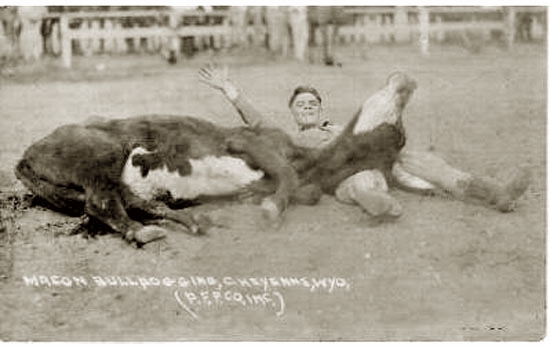
Bulldogger signaling time. Photo by Ralph Doubleday.
Originally, bulldogging rules required the one of the steer's horns to be forced into the
ground. This had the impact that the cowboy and steer would summersalt with the possiblity that
the cowboy might be crushed beneath the steer or that the steer's horns or neck might be broken.
Thus, by 1936, the rules for bulldogging had evolved:
Each wrestler must make at least one catch from his horse.
Steers are numbered and drawn for.
Wrestler and hazer are allowed to leave chute with steer, but wrestler
must not leap before crossing dead line.
Steer must be thrown by hand, not knocked down.
Wrestler must signal with one hand for time when steer is thrown.
If wrestler lets steer up before being told, 30 seconds shall
be added to his time.
Best total time for all steers wins final money.
A time limit of two minutes is placed on wrestling.
If wrestler jumps and misses steer, he is allowed only
the help of his hazer in catching a remounting horse.
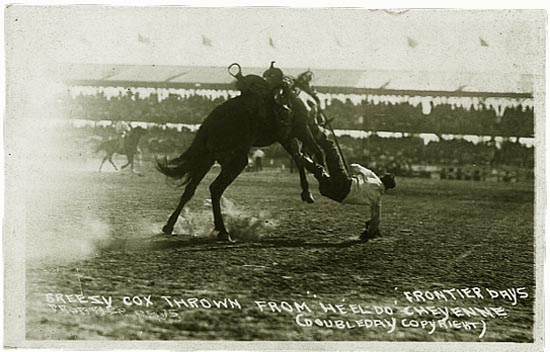
L. B. "Breezy" Cox, being thrown, undated, photo by Ralph Doubleday
Lionel Bert "Breezy" Cox ((1900-1960) won the Calgary Saddle Bronc contest in 1925 and 1st in Calf Roping and "all-around cowboy at Calgary
in 1926.
In 1940, he started a string of race horses. Cox retired from rodeos about 1956 after he broke his leg. Toward the
of his life he trained a bison named "Lollipop" which later became the mascot for West Texas State University.
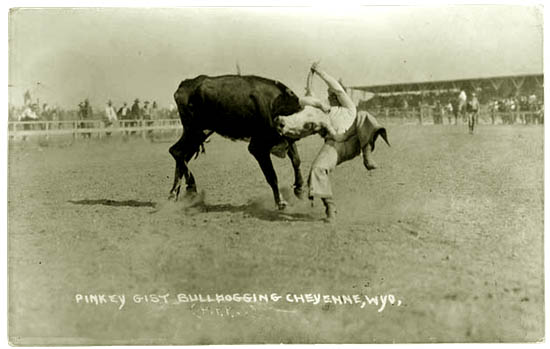
"Pinky" Gist, bulldogging, approx. 1922, photo by Ralph Doubleday
Clarence W. "Pinky" Gist (1892-1970) in the 1930's, 1940's and 1950's became a rodeo clown. As a part of
his act he had two mules named Mickey and Freckles. The bulldogging contest in addition to
Gist, included such well known bulldoggers as Yakima Cannutt, Earnie Green, Dick Kirnan, Jim Massey, Shorty Kelso, Buck Lucas and Billy Kingman.
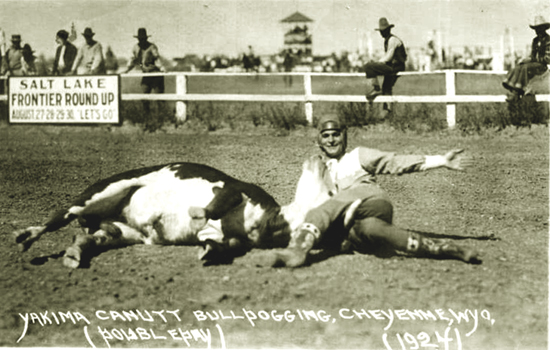
Yakima Canutt, bulldogging, 1924, photo by Ralph Doubleday
Enos Edward "Yakima" Canutt (1895-1986) was the first winner of the "Roosevelt Trophy" for most cumulative
points won in a single year at Cheyenne and Pendleton in Bronc Riding, Steer-Roping, Bulldogging and Wild Horse events.
The trophy was establsihed by New York's Roosevelt Hotel in 1923 in memory of the "Cowboy President."
The trophy was retired by Robert Anderson "Wild Horse Bob" Crosby after Crosby won the trophy three times, 1925, 1927, and 1928, a feat which
at the time had been regarded as impossible.
Canutt was on the rodeo circuit from 1914 up untill 1929. At the same time he appeared in a number of silent films including
"Devil Horse" filmed on the North Fork of the Shoshone outside of Cody. The hero of "Devil Horse" was, however Rex, the Wild Horse, who
played the lead opposidte Lady. Perhaps the most famous of the movies in which Canutt played was
"Stage Coach" in which Canutt was the stunt double for John Wayne in the scene in which he drops from the
speeding horses pulling the coach and slides back beneath the horses' pounding hooves to come back again up onto the coach.
Wayne adopted Canutt's drawl and walk in his movie parts. Wayne admitted,
"I spent weeks studying the way Yakima Canutt walked and talked. He was a real cowhand."
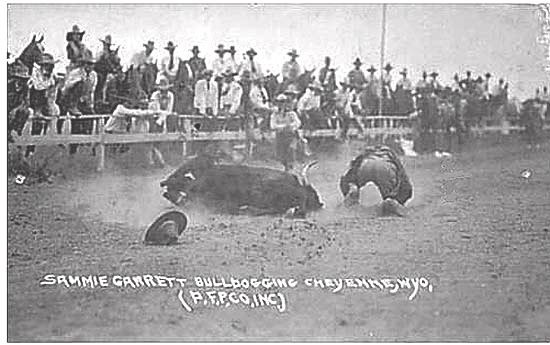
Sam J. Garrett, Bulldogging contest, undated, photo by Ralph Doubleday
Sam J. Garrett (1892-1989) was a champion roper who received his start at age 14 with
the Miller Bros. 101.
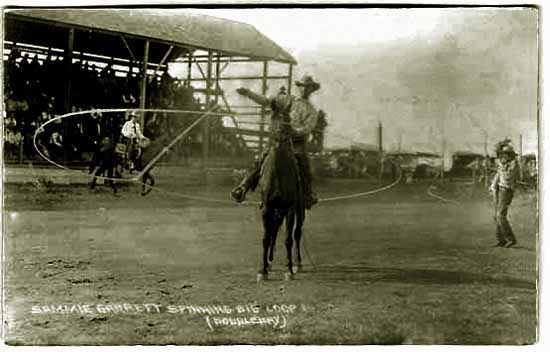
Sammy Garrett swinging big loop. Photo by Ralph Doubleday.
Garrett won the 1912 Frontier Days Fancy Roping Contest and later played in
some western movies, including the lead in Big 4 Films Corp.'s 1931 Flying Lariats.
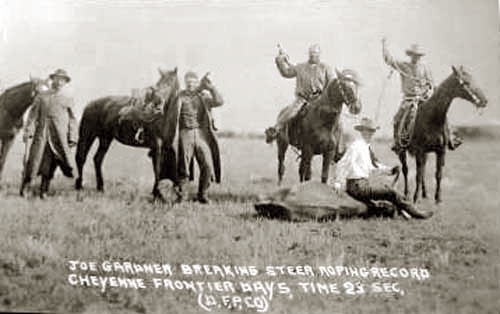
Joe Gardner in Roping Contest, 1920, photo by Ralph Doubleday.
Joe Gardner (1877-1921) won the world championship roping contest in Chicago in 1920. His win in
the 1920 Cheyenne roping contest was described by The leader, July 30, 1920:
Joe Gardner of El Paso was one of the conquerors. He roped his first steer in 25 seconds flat, and then, just
to show that it wasn't a matter of luck, turned around and got a second brute in 22.4. The latter is just one second more than the
world's record.
Following Gardner's performance it was announced that he had established a new record for the Cheyenne field. The firgures show,
however, that in 1916 Fred Lowry did the roping stunt in 24 flat, and that his mark was subsequently lowered to 21.4 by another man. That time still stands.
In his second trial Thursday the Texan had the good fortune to get a steer which did not appear to be
particularly angious to get away with the result that he had his rope round the horse within 100 yards of the corral. From then on it was only
a matter of a few short seconds until the animal was down and its four legs bound together as tightly as a thirsty man's hold on a bottle of
wet goods in this year 1 A.P. (After Prohibition.)
Gardner also rode in
"staged" rodeos with Tom Mix, Will Rogers, and William S. Hart. His father, John Henry Gardner,
was an early Texas cowboy who trailed cattle from Texas to Ogallala and Montana. On one trip up to
Deadwood City, other cowboys included Joel Collins and Sam Bass each of whom went on to
infamy as road agents. When Joe Gardner died of stomach cancer, Lupe Loya, a nom de plume
for Lela Cole Kitson (1896-1970) wrote in Street & Smith's Western Story Magazine of Gardner's horse
"Skunk:"
At the ranch near Sierra Blanca waits a gray horse, "Skunk," which Gardner
rode during the last ten years of his life, and which shared with him the
honors and plaudits of fame. Never more will Skunk dash into the arena in
pursuit of a wild bovine, with the cheers of the multitude ringing in his
ears; never more will the rider he loved rub his silky neck after the
laurels are won and tell him he is "a good old hoss." But Skunk can be
patient, because it won't be long now before he, too, must strike out on
that long sunset trail; and if the justice prevails in the world beyond
which we hope and believe exists, then Skunk and his beloved rider may meet
again. Quien Sabe?
Mrs. Kitson, women's page editor for the El Paso Herald-Post, also wrote under the pen name of
Shirley Manners. In addition to Western Story Magazine she wrote for Thrilling Ranch Stories and
Ranch Romances. She wrote among other stories the 1925 The Cactus Turns the Other Cheek.
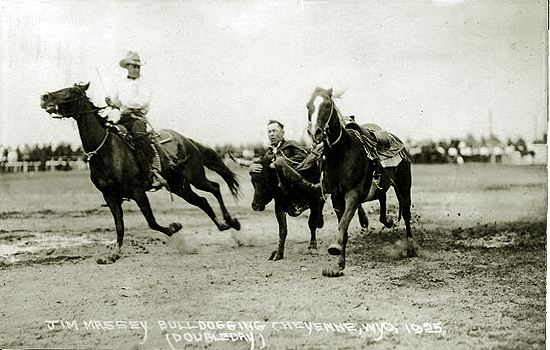
Jim Massey, bulldogging 1925
Jim Massey won at Calgary in 1912. He used a style similar to Will Picket's ""bite 'em
style of bulldogging." Others who used the same method included Mike Hastings, Buffalo Vernon,
Shorty Kelso, and Milt Hinkle.
Next page, Frontier Days continued, Cowgirls, Husband and Wife Teams.
|